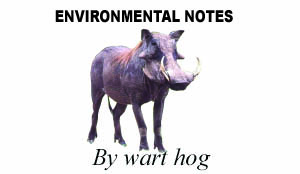 AN old member of the Wildlife and Environmental Conservation Society of Zambia found his family at home had killed a snake.
AN old member of the Wildlife and Environmental Conservation Society of Zambia found his family at home had killed a snake.
The Society member was dismayed with the killing that took place at his residence.
Despite that, he had interest in finding out more about the snake and thus decided to take it to Wart Hog for identification.
The dead snack was wrapped in a plastic bag and Wart Hog noted that it was rather large, with big eyes and olive green in color. At this point, Wart Hog noticed that the dead creature was a Boomslang snake.
These coloring variations are the greatest of any other snakes in their Afro-tropic regional habitat. The adult females are usually brown in color whilethemales have a light green color often with black or blue highlights outlining the edges of their scales.
This snake is a one deadly animal because of its preference for aerial positioning in tree top and shrub cover. Hard to see in the thick forested cover of the savanna, the Boomslang Snake is well camouflaged and strikes without giving any warning signal.
The Boomslang delivers potent hemotoxic venom to its victim through large, deeply grooved folded fangs positioned in the rear of its mouth; this snake bite can be fatal if left untreated.
Average length is 100-160 centimeters (approximately 3.5 to just over 5 feet in length) with some snakes recorded to have been over 6 feet in length.
The most readily identifiable physical feature of the Boomslang is its exceptionally large eyes proportionate to its distinctive egg-shaped head. If agitated, the Boomslang moves quickly and will inflate its neck to double its normal size right before striking its victim.
Equipped with stereoscopic vision, the Boomslang hunts during the day in its territory; making meals of chameleons, lizards, frogs, and occasionally small mammals, birds and eggs from nesting birds which they swallow whole.
The Boomslang is a very unusual snake in that it is one of the very few poisonous snakes identified in the Colubridae snake family. Colubrids are the most common snakes with over 2,000 species worldwide, most of which are non-venomous snakes, including the Kingsnakes and Milk Snakes, Black Racers and Ribbon Snakes, all very popular species in the captive bred reptile industry.
Boomslangs share this rare poisonous Colubrid classification with only one other snake, the Bird Snake (Thelotornis kirtlandii).
The bite strike of the Boomslang, with dominant hemotoxic venom, affects the circulatory system destroying red blood cells causing organ degeneration and generalized tissue damage.
Snakes with this deadly venom are classified in the group known as Solenoglyphawhich includes many of the snakes in the Viper families Viperidae (True Vipers) and Rattlesnakes, and the Vipers have bites causing intense pain, swelling and necrosis even when delivered in small amounts, these snake bite causes severe hemorrhaging continuing for extended periods, even 24-48 hours after strike contact, making the Boomslang very dangerous to man.
Fairly common throughout Sub-Sarahan Africa, the Boomslang occupies the same territory as the Twig Snake, Cobra, Puff Adder, the Green Mamba and the greatly feared Black Mamba.
The mating season for male and female boomslangs has been observed to be in December and January. Females follow hormonal trails left behind by the males.
Unlike most other snakes, boomslangs can mate in trees. They also can mate on the ground. They do not mate for life, but there is little information on how many mates a Boomslang will have in its lifetime.
After mating, there is a period from four to eight weeks before the female lays eggs. These excellent tree climbing snakes are oviparous, laying up to 8-25 eggs usually in the hollows of a tree or in mounds of leaf litter. After the eggs have been laid, the female generally leaves the eggs alone and never returns to check on the young. Young Boomslang snakes hatch 70-100 days later. The snakes hatch using a special “egg tooth” to work their way out of the shell. At birth, the length of the baby snake ranges from 29 to 38 cm.
As hatchlings, boomslangs need to eat every two or three days. At this stage, their diet consists mainly of smaller reptiles. Their first skin shedding occurs when they are approximately ten days old.
For more information get a guide to Reptile Amphibians and Fishes of Zambia from the Wildlife and Environmental Conservation Society of Zambia.
Wildlife & Environmental Conservation Society of Zambia
P.O. Box 30255, Lusaka, Zambia.
Telefax: 260-211-251630, Cell: 0977-780770
E-mail: wecsz@coppernet.zm






